| |||||||
| Search Forums |
| Advanced Search |
| Go to Page... |
 |
| Search this Thread |  645,740 views |
| | #1 |
| Team-BHP Support  | Hyundai Elantra : Official Review The Hyundai Elantra has been launched in India at a price of between Rs. 12.99 - 19.19 lakhs (ex-Delhi). What you'll like: • Fluidic design is stylish & contemporary. Will appeal to many • Priced well - among the lowest in the segment. Offers the most value for money • Spacious, high quality interiors • Refined diesel & petrol engines mated to smooth 6-speed automatics • Suspension delivers a comfortable ride & neutral dynamics • Loaded with kit! Hands-free boot, ventilated seats, Eco / Sport driving modes, HD ICE etc. • Top safety rating. Has 6 airbags, ESC, VSM, hill-start assist & more • Hyundai's reliability, competent after-sales & 3 year unlimited km warranty What you won't: • Neither engine offers explosive performance. 1.6L diesel lacks the punch of competition's 2.0s • Uninvolving to drive. Jetta & Octavia are a lot more fun on the highway • Conservatively tuned AT can't match the speed of the VW group's DSG • Some missing features (auto wipers, folding rear seat, glovebox illumination...) • Shockingly, the Manual SX(O) is lesser equipped than the Automatic SX(O) • Diesel AT - a popular combo - is available only in the top variant. No choice of trims Last edited by Aditya : 28th October 2016 at 11:14. |
| |  (44)
Thanks (44)
Thanks
 |
| The following 44 BHPians Thank Aditya for this useful post: | Aficionados, anilntny, arup10, aviat18, Col Mehta, Contrapunto, DrANTO, dZired, frewper, fusionbang, Gannu_1, Grand Drive, GTO, harsh79, iliketurtles, Karthik Chandra, KK_HakunaMatata, Klub Class, Leoshashi, mh09ad5578, MSAneesh, NetfreakBombay, noopster, phoenixash, RavenAvi, RSR, SaiSW, sayakc, scopriobharath, Simhi, Singh09, SmartCat, ssoni.1411, StepUP!, swiftnfurious, theexperthand, thewhiteknight, Tojo_GotBhp, valapad, vibbs, Vid6639, VijayAnand1, vredesbyrd, yosbert |
| |
| | #2 |
| Team-BHP Support  | Review Index: Exterior Last edited by Aditya : 28th October 2016 at 10:29. |
| |  (10)
Thanks (10)
Thanks
 |
| The following 10 BHPians Thank Aditya for this useful post: | frewper, Gannu_1, GTO, Karthik Chandra, Klub Class, phoenixash, RavenAvi, RSR, StepUP!, Vid6639 |
| | #3 |
| Team-BHP Support  | Exterior The D1 segment hasn't been doing very well in India. In fact, the only strong-selling car in the segment is the Mahindra XUV500, an SUV! Sedans in this segment have witnessed falling sales and that resulted in Honda pulling the Civic out of the market (related thread). There have been rumours of Volkswagen dropping the Jetta from its line-up as well. While the fifth-generation Elantra was well-received at the time of launch and outsold the Corolla Altis then, its sales slowed down eventually. One reason is age - in this segment, the latest is the greatest. Then, there was the new Corolla Altis which has held onto the no.1 position since launch (helped in no small part by fleet sales) & the new Skoda Octavia. Lastly, it's the Indian market's fascination with SUVs, and the fact that C2 sedans have gotten so much more competitive. Hyundai gave the car a facelift in 2015, but it didn't manage to change the car's fortunes. Hyundai will be hoping that the new Elantra turns things around. The car has been introduced at a time when other manufacturers appear to be either pulling out of the segment or have no upgrades scheduled in the near future, which limits the choice for customers. Perfect time to bring the next generation in then. The Elantra has always been well-priced in this segment and the latest generation is no different. Price-wise, with the exception of the top-end diesel MT and AT, the Elantra undercuts the Corolla. To ensure that the Elantra sells well, Hyundai has equipped it with a plethora of features. The car also comes in both petrol & diesel versions with MTs and ATs. The company is offering a standard warranty of 3 years / unlimited km (which outclasses the Corolla's warranty of 3 years / 1 lakh km), 3 year roadside assistance, 3 year/ 30,000 km free maintenance, 3 map updates and 3 home visits. The warranty is extended for the fourth year for free if you currently own a Hyundai (as a part of Hyundai's loyalty programme). Hyundai released teaser images of the Elantra in August 2015, while the car was revealed the month after. In India, the Elantra was spotted in February 2016. Hyundai claims that the new Elantra is built on a new platform made of 53% advanced high strength steel (AHSS). AHSS components are used to increase chassis stiffness and protect passengers effectively in a collision. To its credit, the Elantra scored the Top Safety Pick Plus Rating in the IIHS (Insurance Institute of Highway Safety, USA) crash tests.  Looks-wise, the new Elantra uses Hyundai's "Dynamic Precision" Fluidic 2.0 design language. It's clearly an evolution of the outgoing car's styling. That said, it is 40 mm longer, 25 mm wider and 5 mm lower than the outgoing car. At 2,700 mm, its wheelbase remains identical to the old car. As we have come to expect of Hyundai, the paint quality and build are impressive and panel gaps are even. Even the gaps around the bonnet and boot aren't much wider than in other areas. Front end is dominated by a large hexagonal grille. Much more edgy and aggressive than the fifth-generation Elantra:  Fluidic rear wears many creases. Tail lamps bulge out from the sides. Apart from the badges, there is no chrome used anywhere (we love it this way!):  Strong character lines along the sides – characteristic of Hyundai's Fluidic design. Fit, finish and paint job are excellent: 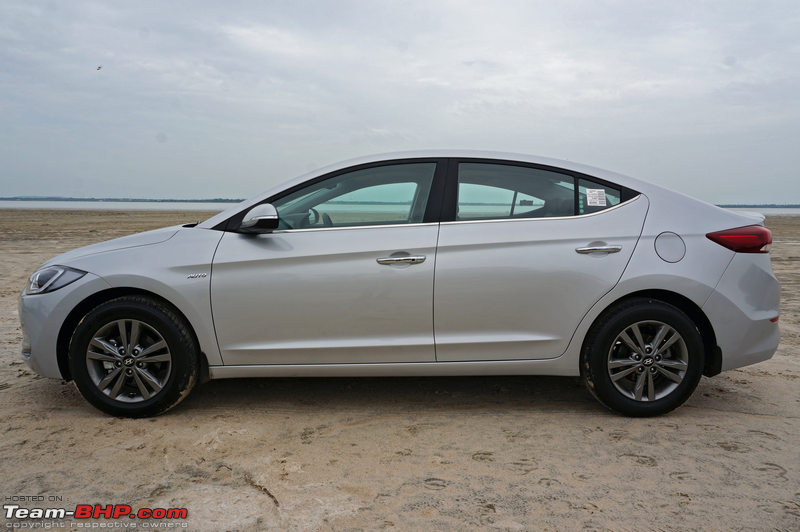 At 4,570 mm, the Elantra is the shortest car in its class. However, its 2,700 mm wheelbase is the longest:  Viewed from this angle, the Elantra looks more like a coupe than a sedan...with the slope of the roofline continuing all the way to the boot:  Wraparound headlamp clusters aren't swept back like the outgoing model. They consist of LED daytime running lights (DRLs), projector HID headlamps & halogen main beams. Headlights have an 'automatic' function. Notice the sharp chrome insert:  DRLs are on by default. Switching on the headlamps makes them dim a little:  An image of the headlamp cluster with all the lights in action. When you lock the car with the button on the keyfob or the request sensor (on the door handle), the indicators blink once. When you unlock, they blink twice. One single horn of the two is blown with the indicators. Flash the headlights and the projectors + main beams (both) come on. There is a follow-me-home function as well where the headlamps and tail lamps stay on for 30 seconds or so after the car is switched off (the headlight switch should be in the "Auto" position):  Bright DRLs grab the attention of other road users:  Bumper has L-shaped foglamp housings. The lower lip is black and continues as underbody protection: 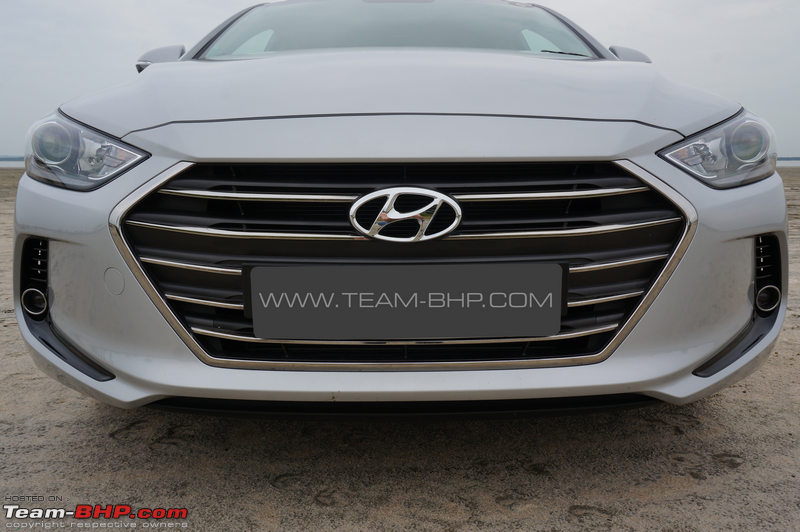 Large grille takes inspiration from Audi. The bumper does not split it into a radiator grille and air dam (separately). It gets horizontal chrome slats, a large chrome Hyundai logo and a chrome border too. Thankfully, the chrome does not look overdone:  Good deal of underbody protection at the front:  Cute foglamps are projector units as well and provide sufficient illumination. Foglamp housings get a piano black finish, which gives them a premium look: 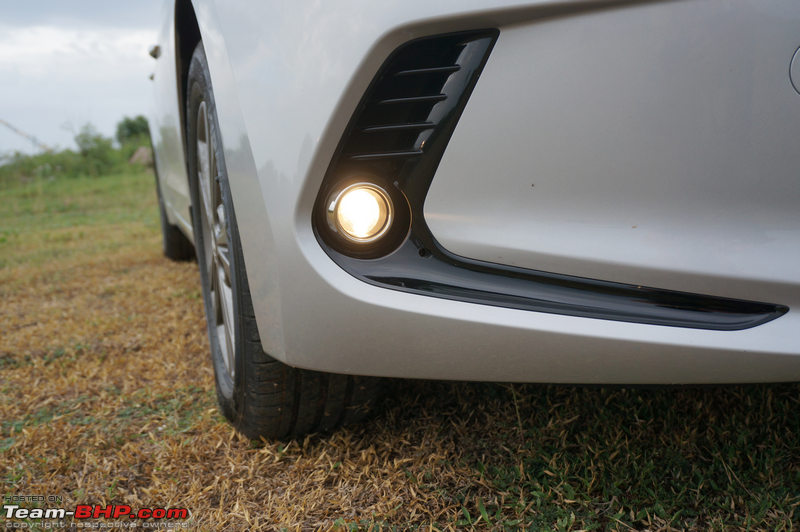 Tow-hook cap has an arrow indicating where you should press it: 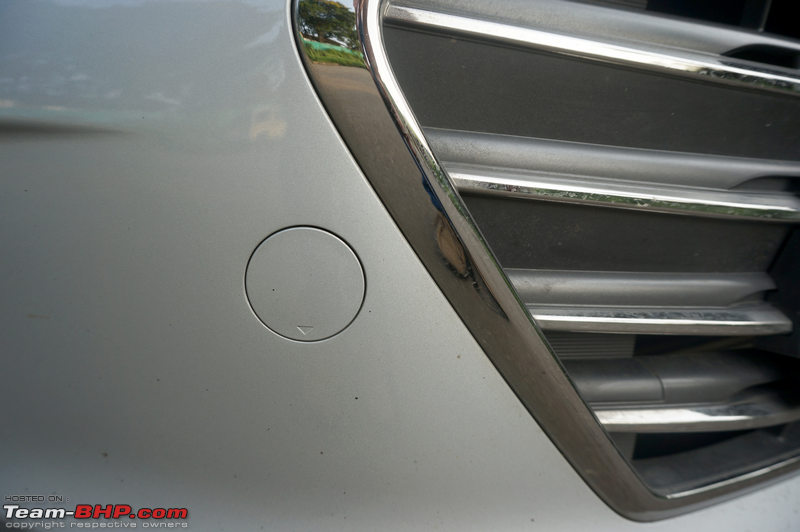 Small flaps ahead of the front tyres to manage air flow: 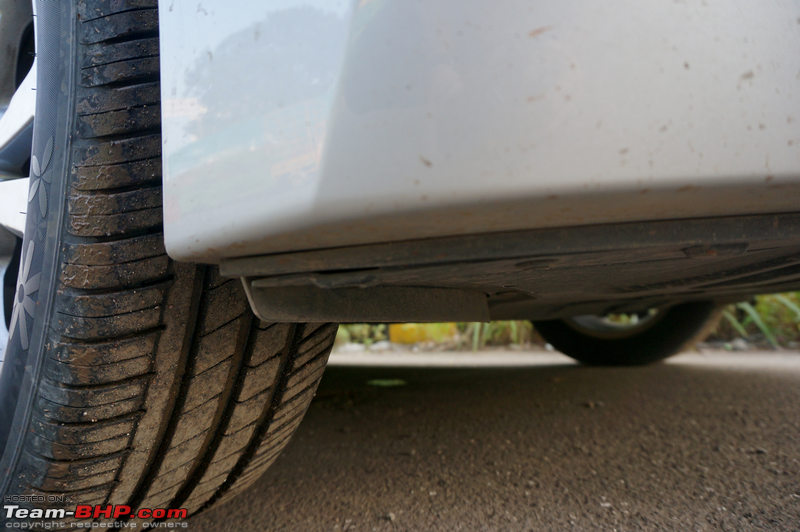 Very prominent crease on the bonnet. Headlamps appear to bulge out from the sides:  Windshield washers neatly hidden under the bonnet:  Both windshield washers squirt out effective sprays (rather than jets) of water. The big wipers have a good sweep:  VTVT badge on the front right fender denotes the petrol engine under the hood. Diesel versions get a CRDI badge: 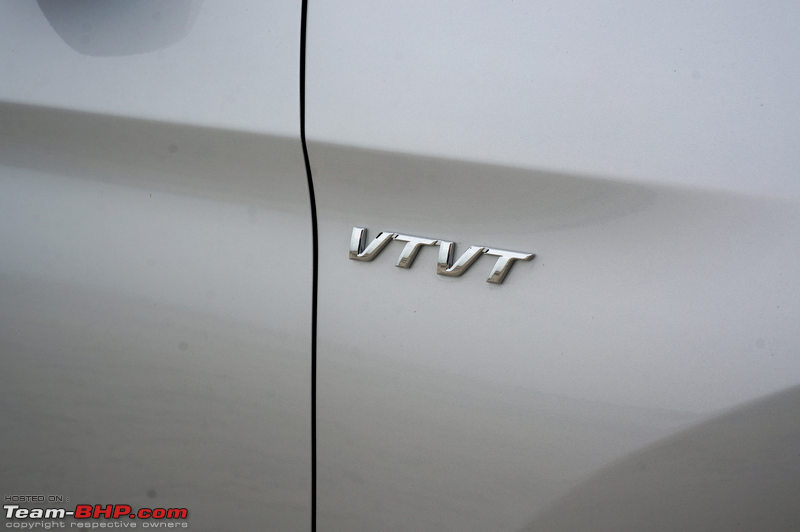 Auto badge on the front left fender. Manual transmission variants don't get any badging:  Body-coloured ORVMs get integrated blinkers with subtle chrome inserts. They are auto-folding. Just like the Elite i20, they open automatically even when you walk up to the car with the key on your person: 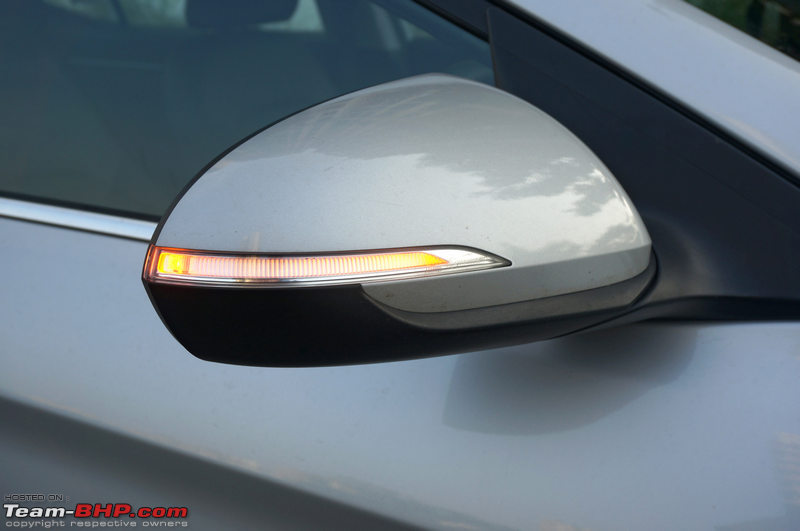 Chrome door handles. Both front doors get request sensors (keyhole only on driver's side). Simply walk up to the car with the key on your person and touch the request sensor to lock / unlock:  Both front door handles get pocket lights (à la BMW). These lights come on when you walk up to the car with the key on your person or unlock the car using the key fob. They stay on for ~15 seconds:  16-inch, 10-spoke gunmetal finish rims shod with 205/60 section tyres. I like the design more than the one on the outgoing model (image link):  As is the norm in the segment, the Elantra gets disc brakes at the rear as well:  Wheel arches are prominent and lend a muscular stance to the car:  Roof design is round! The window line rises towards the rear and the roofline tapers, limiting the glass area:  Quarter glasses make an appearance on the rear doors, which extend further back than the old car:  The SX(O) AT variant gets a very-welcome sunroof:  Sharkfin antenna sits at the very end of the roof section: 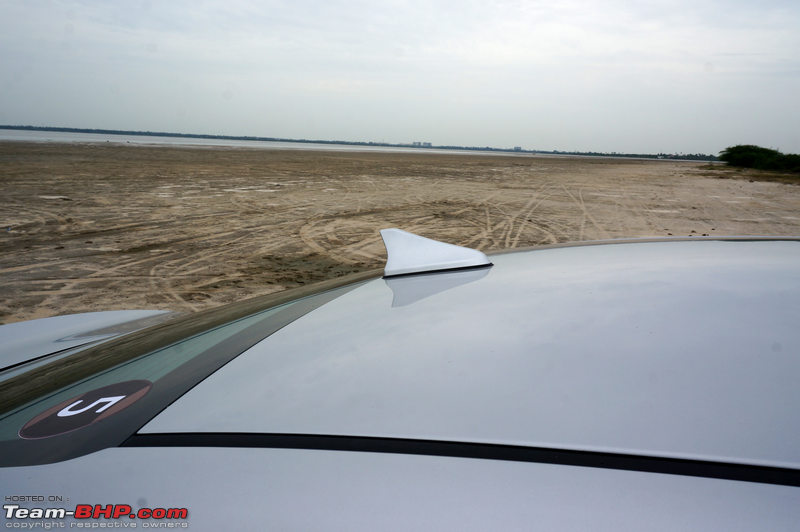 Swoopy & curvy, wherever you look. See how the roof slopes down almost to the end of the boot! 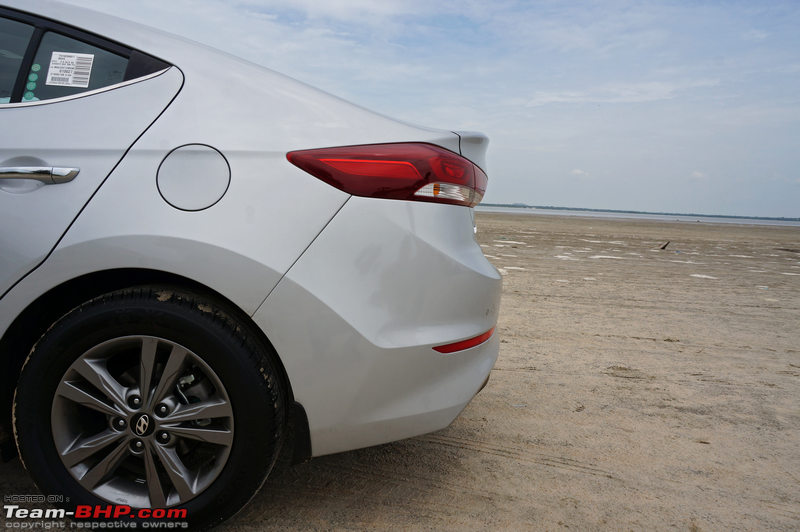 Large wraparound LED tail lamp cluster with all the lights in action. The borders of the red lights come on when the pilot lamps are switched on - FUNKY! Both clusters get reversing lights, but not rear foglamps:  On applying the brakes, the borders of the red lamps as well as the insides light up: 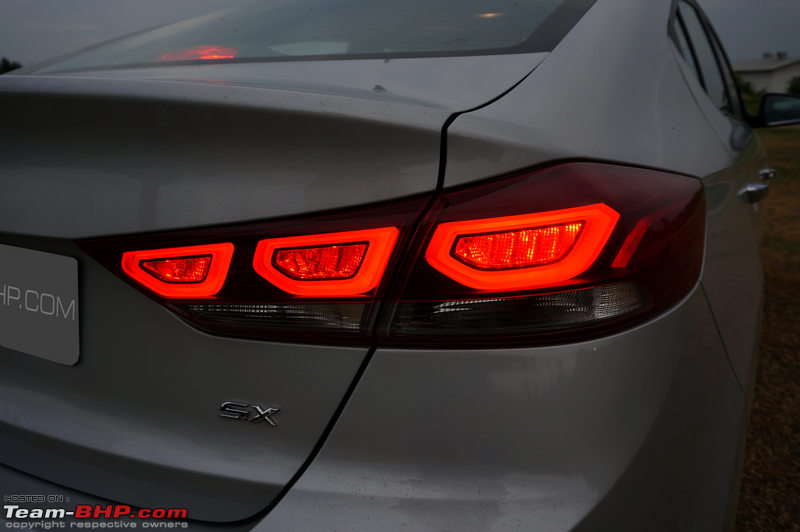 Boot lid gets an understated lip:  Rear bumper houses 4 parking sensors. Along with the reversing camera, these are essential as the rearward visibility is poor. Exhaust pipe is nicely concealed:  Reversing camera is neatly integrated and located just next to the electromagnetic boot release:  Rear bumper has long + slim reflectors at both ends:  Black plastic insert at the bottom breaks the bulky look:  Clean & tidy underbody with sufficient ground clearance. Coupled torsion beam suspension at the rear. Sad, as an independent rear suspension offers superior road manners: 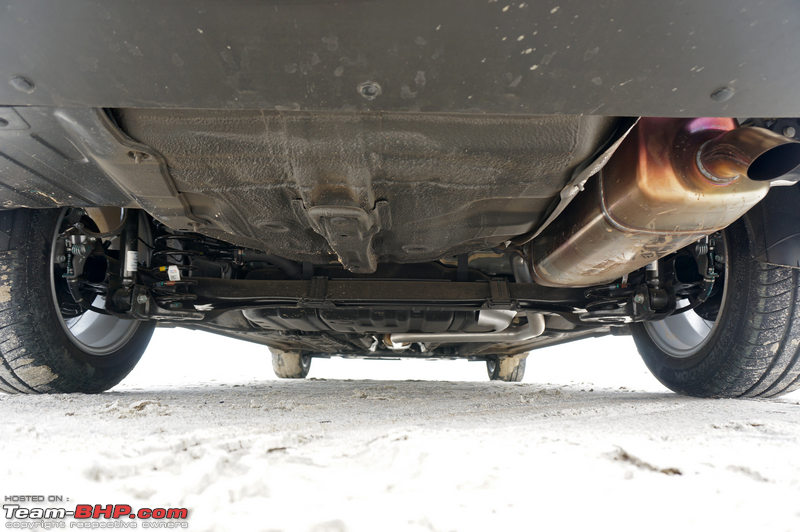 Like the front wheels, there are aero-flaps ahead of the rear wheels too:  Completely different design philosophies - the Elantra is modern & curvaceous, whereas the Octavia is clean & understated. Will appeal to different tastes (I prefer the Octavia):  Last edited by Aditya : 28th October 2016 at 11:35. |
| |  (34)
Thanks (34)
Thanks
 |
| The following 34 BHPians Thank Aditya for this useful post: | Aficionados, akshay81, Crazy_cars_guy, dark.knight, dkaile, espraveen, ganeshb, GTO, iliketurtles, iVento, jfxavier, Karthik Chandra, mh09ad5578, motor_breathing, MSAneesh, noopster, peterjim13, phoenixash, RavenAvi, rev_rohit, RSR, samabhi, Simhi, Skyline_GT, sourabhzen, swiftnfurious, tharian, The Rationalist, theexperthand, Tojo_GotBhp, Vid6639, VijayAnand1, vredesbyrd, Zahoor23 |
| | #4 |
| Team-BHP Support  | Interior - Front The front doors of the Elantra open in a triple-stage action. While the car is on the lower side and ingress & egress aren't as easy as in a Corolla, it's not too difficult either (like the Civic). First thing you notice after getting inside the car is that the dashboard looks completely different to that of the old car. The fluidic theme has made way for a more European-looking unit. That said, it retains the old car's all-black colour theme with silver inserts at various places. Although the front & rear windshields are large, the roofline slopes down and I found the rear windows to be rather small. Still, while the black dashboard, seats and carpets lend a dark look to the interior, there is just enough light entering the cabin to keep occupants from feeling claustrophobic. The pillars and roof lining are light grey, which helps matters. The all-black dashboard with tastefully applied silver inserts and subtle piano black touches is well laid out. As with all Hyundais, the controls are logically placed and very easy to reach + operate. It gets a little boring on the passenger side though - I got the impression that there was very little happening here compared to the driver's side and centre fascia. Anyone who has driven a Civic will feel right at home. The ergonomics, driving position, handbrake + gear lever placement, reach for the power windows etc. are incredibly similar to the erstwhile Honda Civic. While the plastics used don't feel quite as nice as in the Europeans, it is certainly as good (if not better) than the Corolla. Every part is well-finished and there are no rough edges anywhere. Most of the plastics are hard, yes, but the top of the dashboard and door armrests get soft plastics. The seats have fine leather and there is some leather applied on the doorpads as well. The feel, quality and finish of the buttons and switches is satisfactory. Many of these (and more) are shared with other Hyundais and feel like they are built to last. The dashboard is logically laid out and well screwed together. The entire cabin is practical, user-friendly and equipped with likeable features. Ergonomics are spot on as well, and the all-black theme will make sure that it doesn't get soiled easily:  The dashboard of the SX(O)AT variant is identical to the SX(O) (seen above), except for the gear lever console: 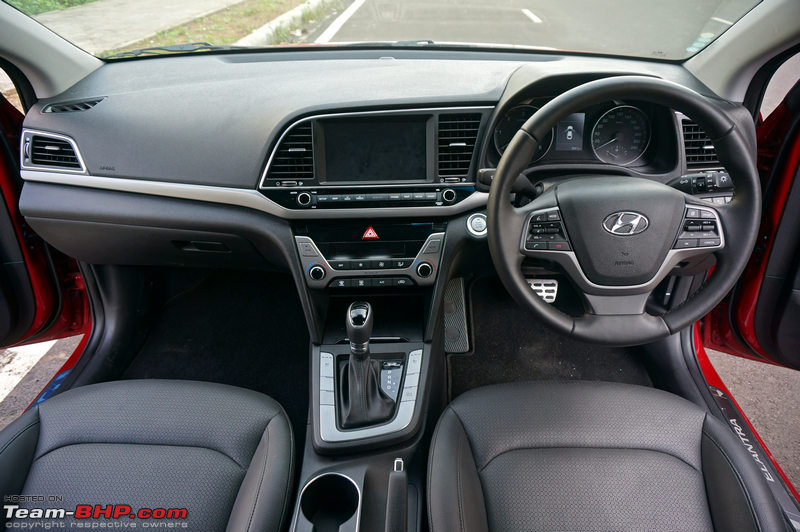 Large front windshield offers a healthy view. The view out of the front windows is satisfactory as well:  Smart leather-wrapped steering wheel has a gunmetal insert + thumb contours. It feels lovely to hold, with satisfactory grip on offer. The steering-mounted controls have large buttons, which makes their operation easy. However, I feel there are too many buttons on the wheel and it looks extremely cluttered! The hornpad isn't easy to reach for those with shorter thumbs:  Buttons for the infotainment system, telephony and voice commands are placed on the left spoke. Mute function (very useful) can be operated by pressing the volume button inward:  Buttons for operating the MID and cruise control are placed on the right spoke. To engage cruise control, press the 'cruise' button on the steering wheel, push the toggle switch downward and a SET indicator is displayed on the MID. Increase or decrease your speed by moving the same switch upwards or downwards:  Zooming in to show the funky stitch pattern on the steering:  The steering offers tilt & telescopic adjustment. Both have a range of ~3 inches, which is satisfactory. It didn't take me any time to set it to my liking:  Instrument cluster is clean and easy to read. Tachometer on the left & speedometer on the right (just the way we like it). Analogue temperature & fuel gauges too, with a 3.5" TFT MID in between. Meters are backlit in white - very classy: 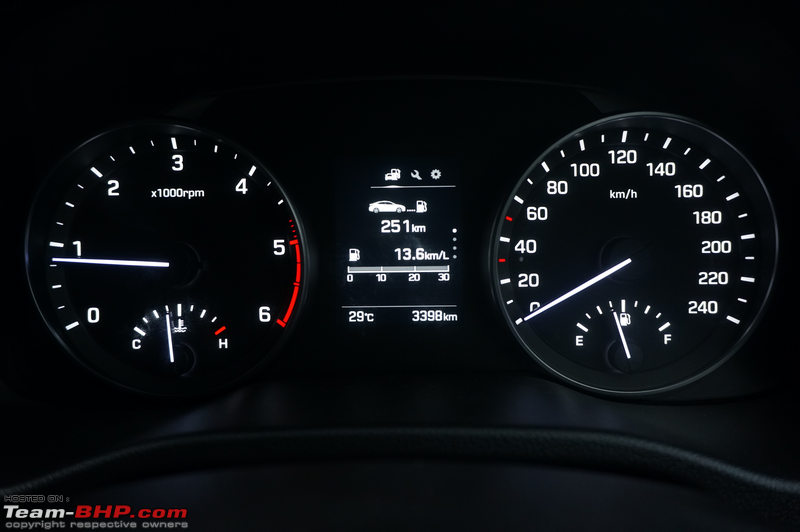 The MID shows two trip meters and a digital speedometer. Both trip meters show the distance travelled, average speed and time taken - specific to that trip meter! On turning the engine off, the MID displays a summary of the drive. Unusual for a Hyundai - the average FE & instant FE are provided! Of course, it has a distance-to-empty counter & outside temperature too. The MID also tells you when the service is due, in terms of months and kilometres. These can be set by the user:  In Indian conditions, you shouldn't ever switch the traction control and ESP off. MID warns you if the front wheels aren't straight when you start the car. The automatic variant obviously shows which gear you have engaged, but uniquely, it also displays the order of the gears (on the shifter). In the MT, a gearshift indicator has been provided. The parking sensor display comes up as soon as reverse gear is engaged. The illumination of the instrument cluster has 21 levels of adjustment (excessive, no?):  To change the MID settings, engage the handbrake (parking gear for the automatic). Parameters that can be customised include auto-locking & unlocking (when you switch the engine off) doors, follow-me-home lights, number of flashes for the 'lane change indicator', service intervals and more. When you change the temperature units, the display on the climate control system also changes accordingly!  The MID also displays the specific door that is open. Neat touch - It shows you the motion of the door being opened (albeit with a little lag):  Boot or bonnet open? It'll flash on the MID:  Wiper and light stalks are similar to the Creta and Elite i20. Quality is excellent and operation is soft. Wipers have five intermittent settings. Sadly, no 'auto' wipers which we'd expect at this price point. You do get auto headlamps though. Foglight switch nicely integrated on the RHS stalk:  Engine start/stop button is backlit in blue. Press the clutch in the MT or the brake in the AT before firing her up:  Press the button without the clutch and an orange light comes on, with the car going in "audio on" mode. Pressing it once again has a blue light showing with the car in 'ignition on' mode. No light when the engine's running:  The shape of all 4 front air vents is different. The air-volume control shuts the flow of air completely:  Switches for disabling the Electronic Stability Control & Traction Control, interior illumination adjuster and headlamp adjuster are located below. To disable the traction control system (required when starting off on ice, for instance), press the button briefly. To disable the ESC, long press the button (we don't see why you should ever do this):  Fusebox is located to the right of the dashboard. The well-finished cover is easy to remove and insert back:  OBD port located at its base. Fusebox has a Master 'On / Off' switch like other Hyundais. In 'off' position, it will automatically cut off current leakage from the battery after 20 minutes. Can be useful for the times when you want to park the Elantra for a longer duration:  A clear diagram of the fusebox is provided on the reverse side of the cover:  Boot and fuel flap releases are located on the floor, just ahead of the driver's seat. Notice how the floor mat is designed to ensure that it doesn’t foul with them:  All-black theme continues on the front doorpads. The door handle is sturdy and finished in silver (like the dashboard), while the insert is finished in gunmetal (like the steering wheel). A tweeter & speaker are housed on the doorpad. The armrest has soft-touch plastics, and there is a leather insert right above it:  Console houses the usual set of buttons. If one of the doors is opened, and you lock the car with the key or the switch on the doorpad, it locks momentarily and unlocks again. Only the driver's window gets one-touch up/down and anti-pinch functions (at this price point, we'd expect all windows to have these). With the mirror's "Auto" button pressed on the right, the ORVMs stay open when you lock the car from the outside. When the button is in the center position, the mirrors close or open on locking and unlocking the car, respectively. Press the mirror button on the left to fold in the ORVMs manually. The lock and window buttons are backlit in blue, but the mirror buttons aren't. The intensity of these backlights is regulated by the illumination switch on the right of the steering wheel: 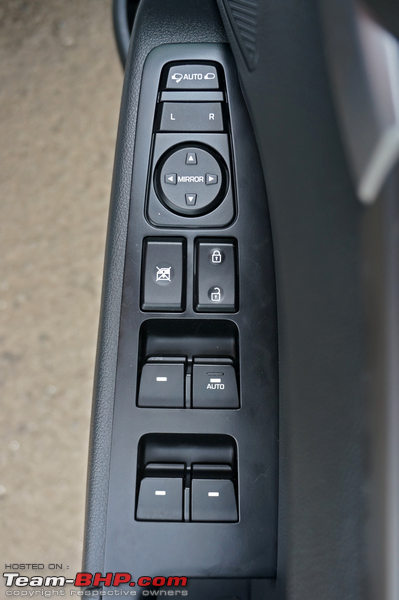 Doorpad can hold a 1-liter bottle, and other small items: 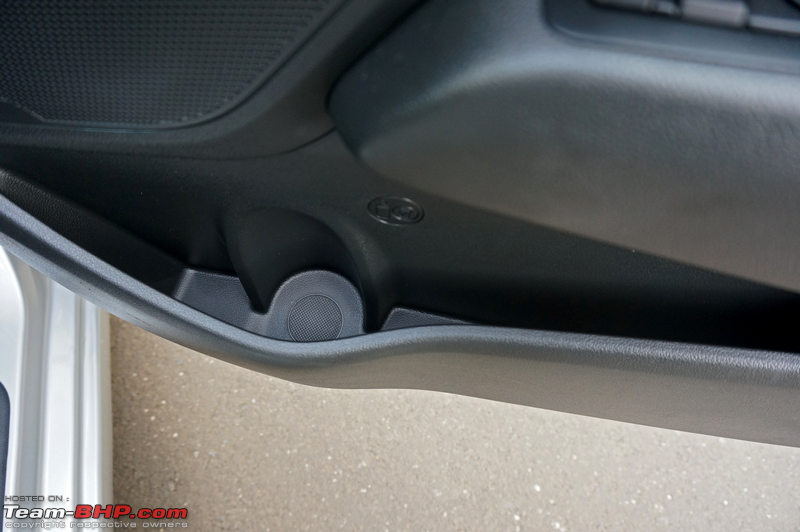 Elantra-branded scuff plates are standard on the top variant:  Sweet looking seats are draped in black leather and have the right amount of firmness. They are wide enough to suit even larger users and offer good lower back + under-thigh support. The headrests are soft and comfortable. Importantly, the seats come with a cooling function which prevents the users backs from perspiring. Such a boon in hot Indian summers:  Driver's seat is 10-way electrically adjustable (including for lumbar support). These switches feel sturdy and durable. Finding a comfortable driving position is so easy:  A look at the seat in the lowest and highest positions. Healthy adjustment range:  The fore and aft travel range is long - like the European cars. Even tall drivers will fit in without complaint:  A closer look at the perforated leather upholstery. It's well stitched and the quality of material is neat: 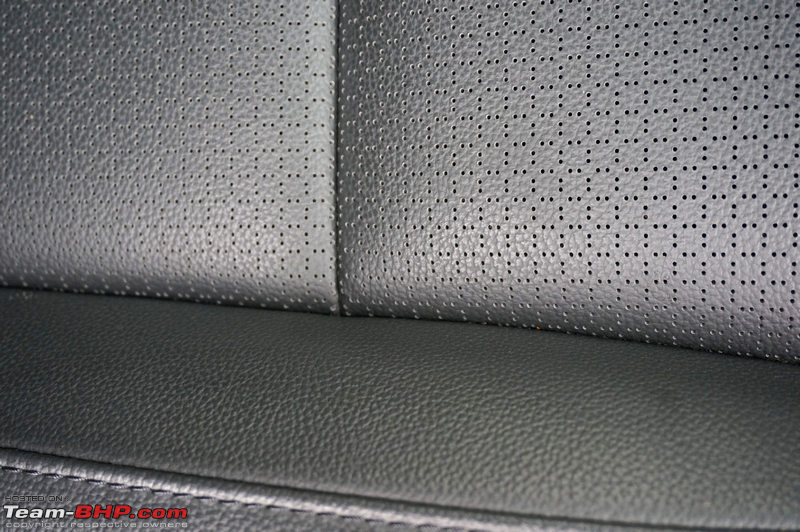 The SX(O) AT gets ventilated front seats. There are separate buttons located on either side of the gear lever for each seat to operate the feature. Pressing the button once takes the cooling straight to level 3 - the highest setting! Pressing it subsequently, brings it down to level 2 & 1, and then off. There is no heating function for the seats:  Manual adjustment for the front passenger seat. It lacks lumbar support and height adjustment as well:  Center armrest is clad in leather and has a soft surface. It's adjustable too:  An image of the center armrest in its extended position. Operating the handbrake is difficult with the armrest in this position. No adjustment for height:  Front seatbelts are height-adjustable:  Pedals are properly spaced out. Aluminium pedals are provided on the SX(O) and… 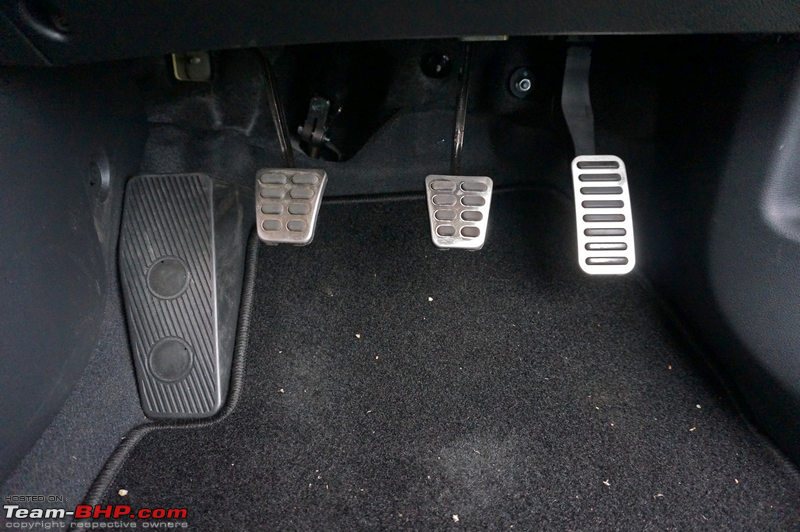 ...SX(O) AT variants. Dead pedal feels too steep for someone who prefers to drive in a higher position: 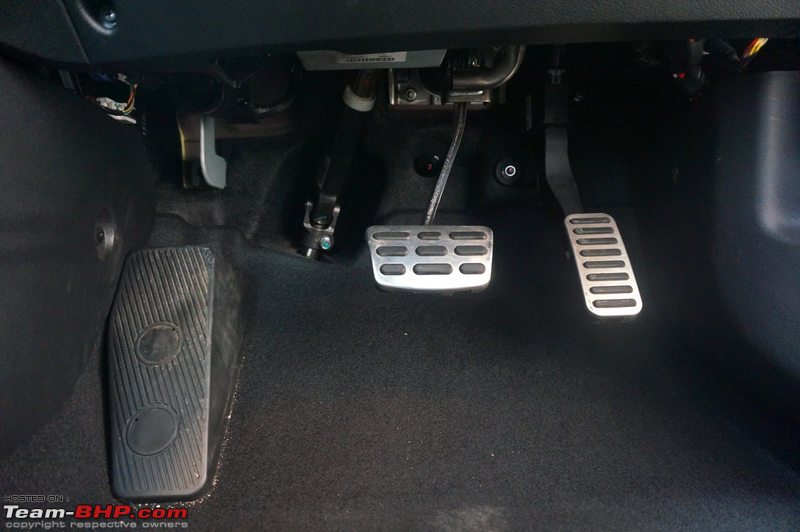 ORVMs are sufficiently wide:  IRVM is wide enough to cover the entire rear windshield. Parcel tray and headrests hamper visibility though:  Sensor for the auto-dimming function is located behind the IRVM. The feature is activated via a button on the front side:  Rearward visibility is restricted by the sloping roofline, parcel tray and headrests: 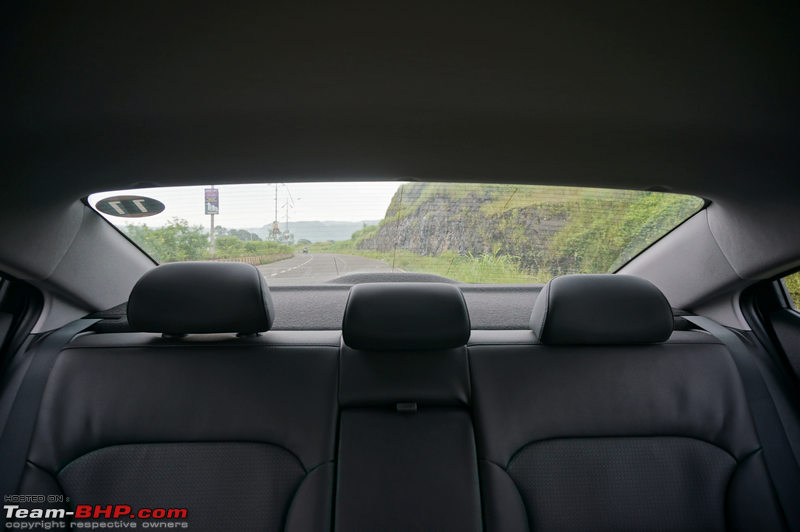 Solar sensor is located on top of the dashboard:  Center fascia tilts towards the driver. The thin chrome insert around the air-con vents and the silver inserts on the climate control + gear lever look classy: 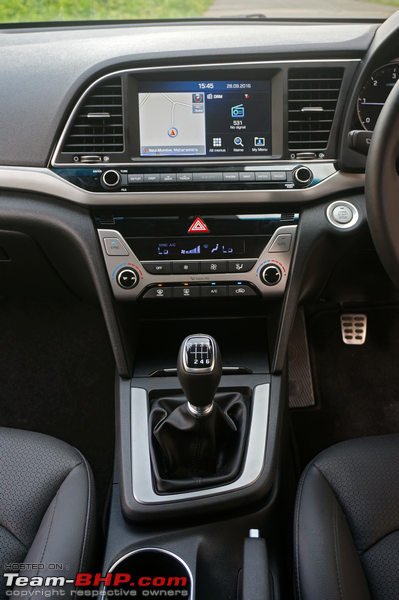 Infotainment system sits right on top of the center fascia. It has a touchscreen and features Bluetooth, USB and Aux-in connectivity with navigation. SD card can only be used for navigation purposes. Flanking the infotainment system are two air-con vents of different shapes. The air-conditioning system is very effective and chilled the interiors in quick time, even on a hot afternoon:  The blower has 8 levels of adjustment. It is silent till level 3, audible at level 4, loud at 5 + 6 and very loud at 7 + 8. The temperature can be taken down to 17.5 degrees C, and then to LO. Sync button means driver + passenger sides have the same temperature. If the passenger side knob is used, sync is disengaged and passenger gets his own climate control zone:  All buttons are backlit in a cool blue, which means you don't have to hunt for them in the dark:  A storage bin is located below the climate control system. It has a lid with a chrome insert on its lip. When the lid is closed, you can keep your mobile phone on it:  The storage bin houses the 12V, AUX and USB sockets. Separate socket for a lighter. Rubber lining is provided on the floor: 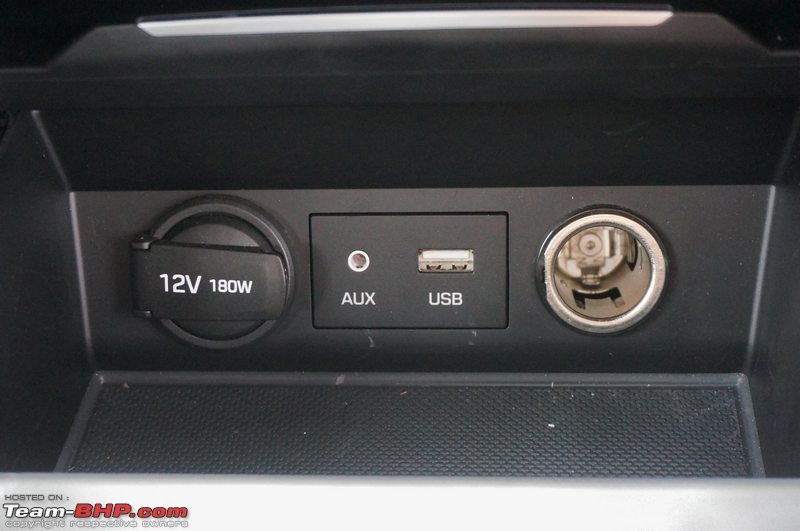 Handbrake is placed right next to the driver's seat, much like the Civic. Two cupholders with a chrome insert are located next to it:  Center armrest has a storage compartment underneath. It has a soft lining on the floor… 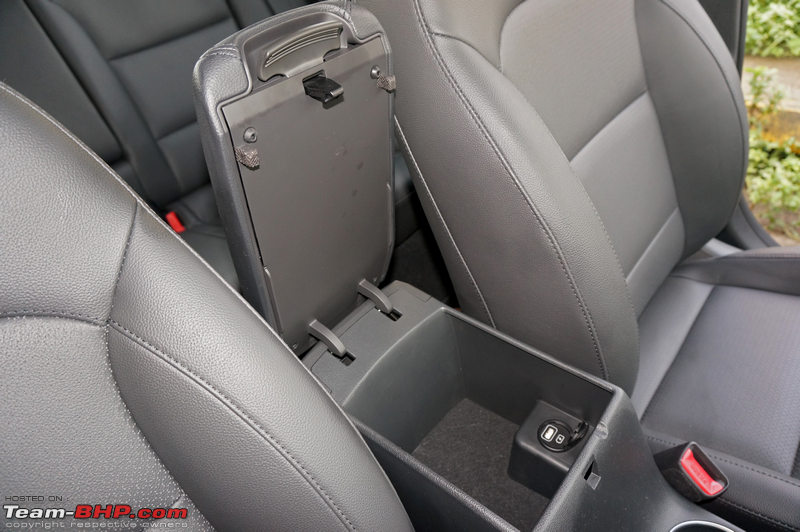 …with a USB charging port:  Dual airbags are standard on all variants of the Elantra. Top variant gets side & curtain airbags too: 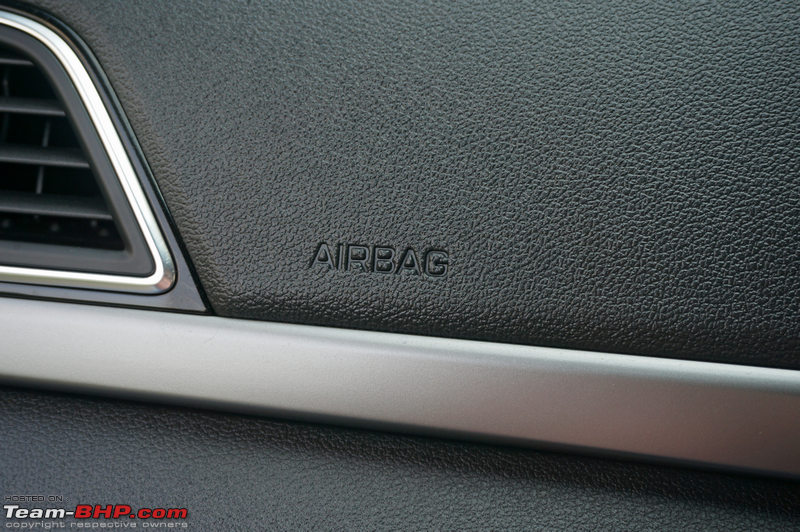 Glovebox is medium-sized. It doesn't have illumination or different compartments…  …but comes with a cooling function:  Glovebox can be easily dislodged by turning the two plastic knobs on either side:  Driver and passenger sunvisors get a covered mirror, illumination and ticket holder: 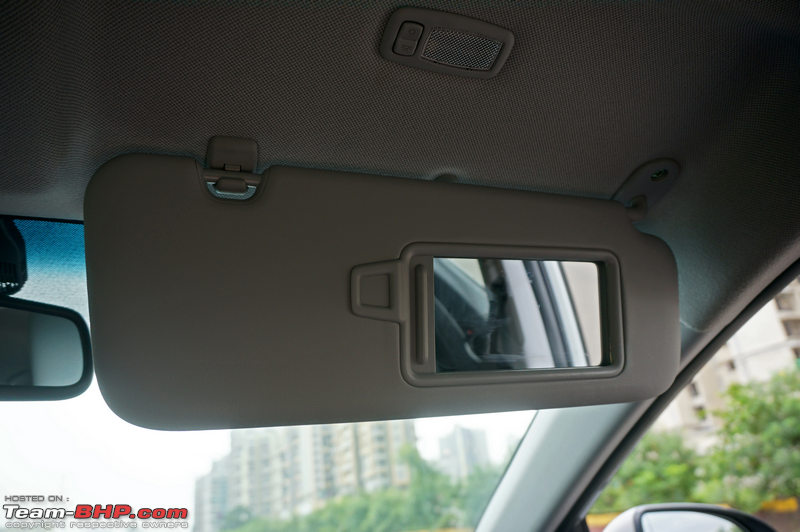 There are lights with switches for both vanity mirrors. Even if you forget to switch off the lights, once you fold the sunvisor back in place, the switch turns to the 'off' position by design. Passenger's sunvisor...  …gets airbag warnings on both sides: 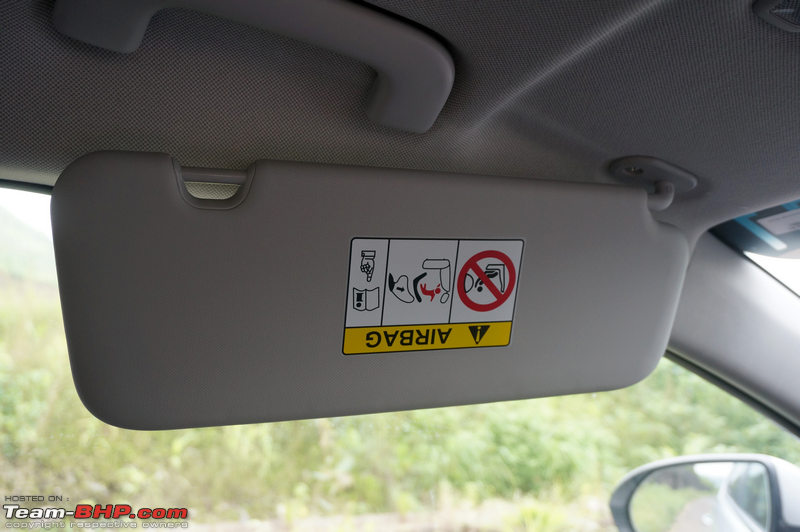 Sensor for the front auto-defogging system is placed behind the IRVM. The system operates when the heater or air-conditioner are running: 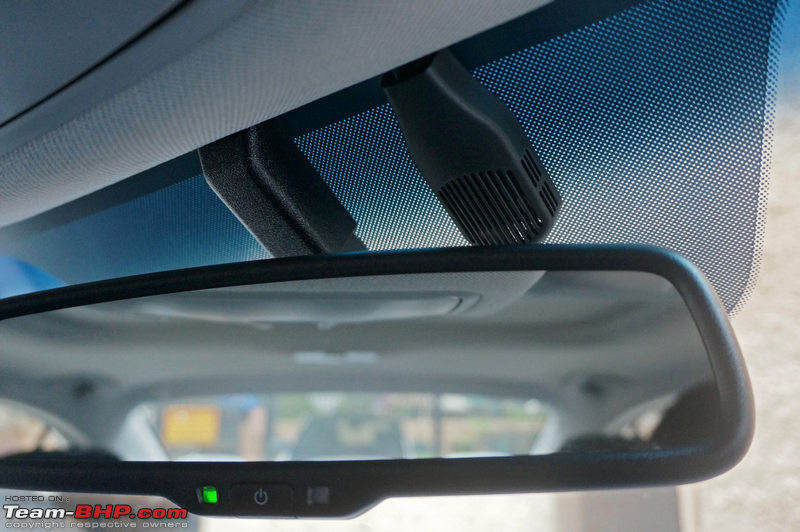 Roof bezel consists of map lights, bluetooth mic, sunglass holder and sunroof controls. You can start the front + rear cabin lights from here. After locking the car, all cabin lights go out with a theatre dimming effect. Even if the cabin lights are left in ON position, they will go off when you lock the car from outside. Excellent touch - battery won't be drained. Also, the cabin lights automatically come on when you switch off the car. They've really thought this feature through:  Sunglass holder has a soft, protective lining on the inside to prevent your sunglasses from getting scratched:  Sunroof cover is manually-operated:  A view out of the sunroof. Its size is on the smaller side though:  You can pop it up for ventilation by pushing the button upwards: 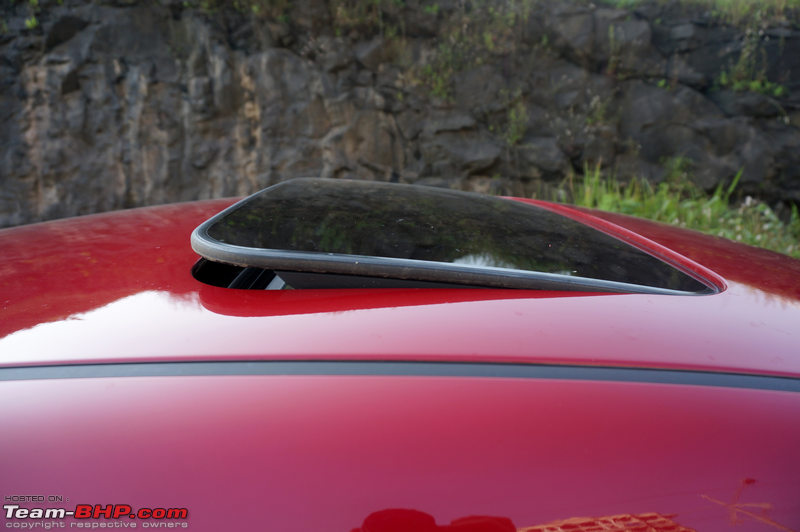 With the sunroof open, a lot of light comes into the cabin. This is the max it opens to:  Last edited by Aditya : 28th October 2016 at 10:43. |
| |  (16)
Thanks (16)
Thanks
 |
| The following 16 BHPians Thank Aditya for this useful post: | anilntny, Crazy_cars_guy, dark.knight, GeneralJazz, GTO, iliketurtles, MSAneesh, noopster, phoenixash, RavenAvi, RSR, samabhi, Simhi, Tojo_GotBhp, Vid6639, vredesbyrd |
| | #5 |
| Team-BHP Support  | Interior - Rear Like the front doors, the rear doors of the Hyundai Elantra open and close in a triple stage action. The door is big and opens wide, but the roofline slopes downward, which means taller folk have to bend in order to avoid bumping their heads. Even the seat is placed on the lower side. Ingress & egress are definitely not simple tasks:  There is more than enough clearance to move your feet in or out:  The door sill is wide, which means you have to make some effort. Door sills get scuff plates with the same design pattern as the ones in the front (but no Elantra badging):  Rear door has a funky, pointed shape! Like the ones in the front, the doorpads are made of hard plastic, with a soft surface for the armrest and a leather insert above it:  Can hold a 1-liter bottle and other knick-knacks. They also house the rear speakers:  Rear bench has sufficient cushioning, but is set low. This means that you sit down on them. At 5'10", I found the under-thigh support to be poor. However, my uncle (5'6") found it adequate. The seat is large enough to accommodate 3 adults. Headroom was sufficient for me, but 6 footers might brush their hair against the roof liner (thanks to the sharp roof design). The seatback angle is nice and relaxed, although the lower back support is average:  All three occupants get soft & adjustable headrests. The seat isn't split and doesn't fold down either:  When not in use, the buckle for the center seatbelt can be tucked away in a cut-out: 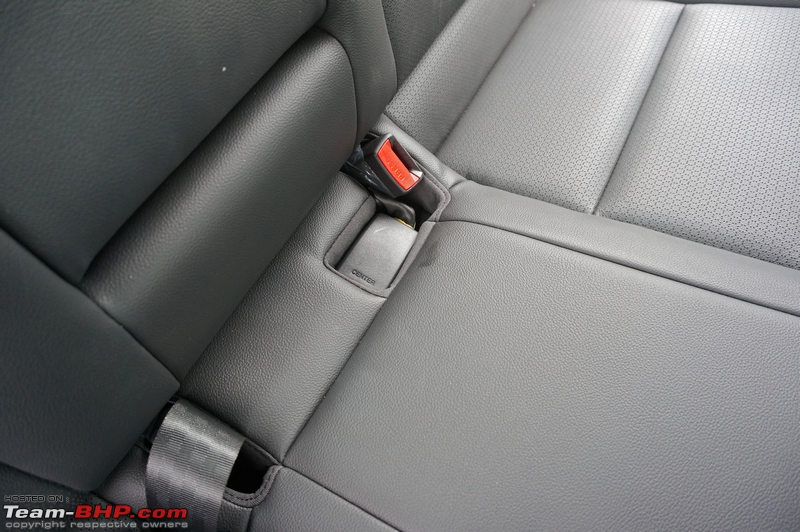 The legroom is impressive and a 6-footer can easily sit behind another one: 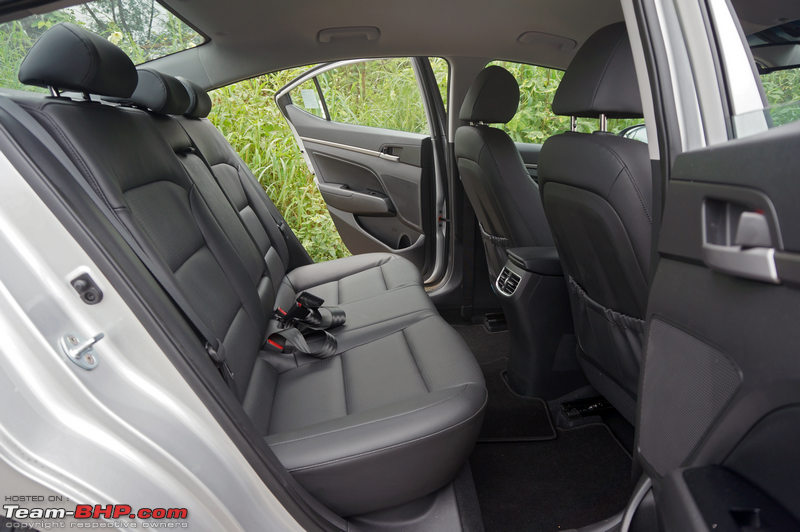 With the driver's seat in my position, I have ~6 inches of knee room. With the front seat in full forward position, it goes up to ~10 inches. However, with the front seat in full back position, my knees touch it. The seatbacks are not scooped out. They have hard plastic surfaces with two small scoops (each) where the rear passengers' knees would be placed. I didn't like the touch of hard plastic on my knees:  Design failure. Bar below both the front seats prevents rear occupants from comfortably sliding their feet under:  A center armrest with cup-holders has been provided. It is thin, but wide and has satisfactory cushioning: 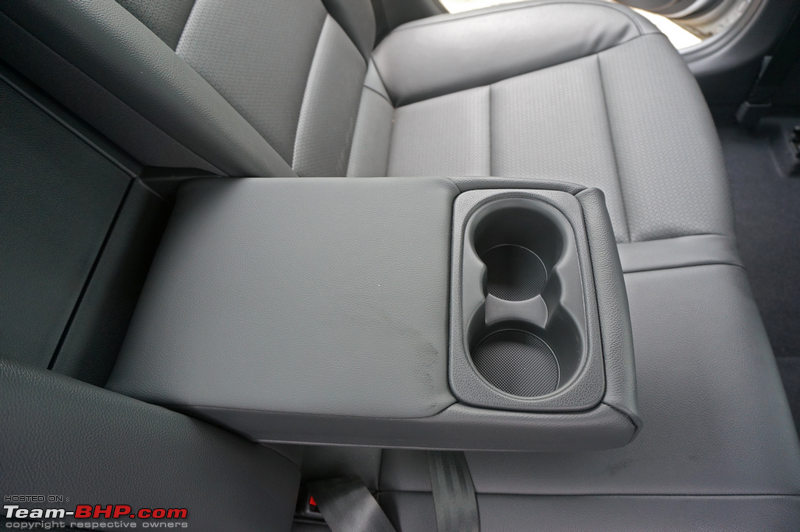 With the center armrest down, you can access the boot by folding down this plastic cover. Good to carry long items (golf club, skis etc.). Like other parts of the car, the fit and finish is topnotch:  Both front seats have seatback pockets to dump small / loose items:  Rear windows roll down almost all the way. They run long, but are rather short in height. The window line is high and shorter people won't find it easy to look out of the windows. Quarter glasses help in increasing the flow of sunlight inside:  Floor hump is about 2 inches high. While not too tall, it is wide - about 4 inches. A passenger sitting in the middle will have to place his feet on either side of the hump:  Rear air-con vents are standard across all variants. While there is only one common air volume controller, their direction can be adjusted individually. Like the vents at the front, air flow can be completely stopped by using the volume controller. The air-conditioner is very effective:  Spring-loaded grab handles are provided on both sides. Only the RHS grab handle gets a coat hook (it is foldable):  Rear cabin lamp has one button with two positions - on (pressed) or door (not pressed). There is no "OFF" position. It can also be operated by using the switch for the front cabin lamps:  The boot has an end to end carpet. While the mouth is sufficiently big, the lip is high, which means you have to lift your luggage that much higher to place it inside. The boot has a "Smart Trunk" gizmo. This is a first-in-segment feature which opens the boot automatically when it senses the smartkey for over 3 seconds within the sensing zone. Very useful if you are carrying luggage in both your hands. How it works - with the car locked, stand at a distance of 50 - 100 cm from the boot, with the smartkey on your person. The car's indicators start flashing with beeps and the boot opens after 3 seconds (there are six beeps in total and the boot opens on the fifth). This system won't work if the Smart Trunk feature is disabled through the MID, or if the smartkey is detected within 15 seconds of the doors being closed & locked. The boot can also be opened by unlocking the car (from inside or outside) and using the electromagnetic boot release, using the boot release lever located inside the car or long-pressing the boot release button on the key fob:  At 458 liters, the Elantra's boot size is no match for the Skoda Octavia's segment-leading 590-liter boot (1,580 liters with the rear seat folded down). In fact, it narrowly beats the Chevrolet Cruze's 450 liter boot (which is the smallest in the segment), and is even smaller than the old Elantra (485 liters)! Even so, it is capable of accommodating a couple of large bags and won't leave an owner embarrassed on an airport run:  View from the boot with the cover in the rear seat removed. We mention again, this can be useful for carrying long objects like golf clubs or skis:  Removable flaps have been provided on both sides of the boot…  …for easy replacement of tail lamp bulbs:  Underside of the boot lid is fully clad - no cost cutting here:  Useful grab handle has been provided to pull the boot lid down:  Boot lamp too. Underside is very unpleasant to look at and doesn't even get a proper coat of paint. While there are no unduly long screws, the unclad hinges and sharp edges look bad:  Tools are housed in a Styrofoam casing, which sits in the spare wheel:  Spare is a full size alloy wheel: 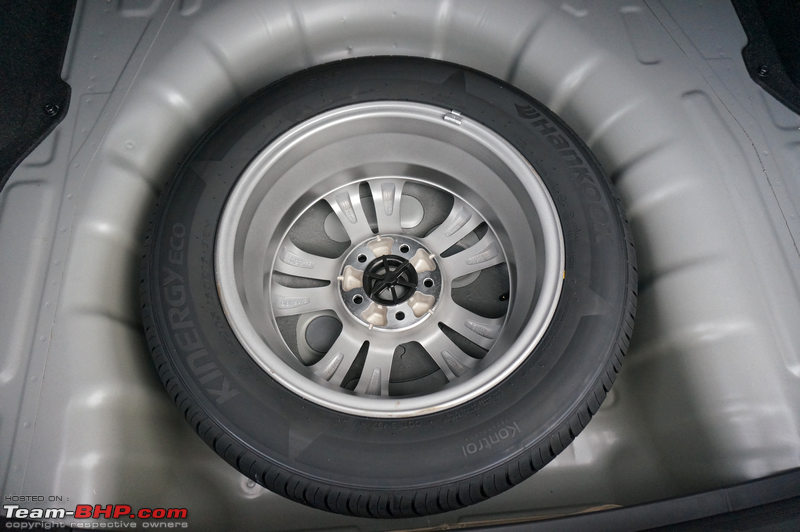 Last edited by Aditya : 28th October 2016 at 10:04. |
| |  (17)
Thanks (17)
Thanks
 |
| The following 17 BHPians Thank Aditya for this useful post: | Aficionados, Crazy_cars_guy, Dennis, dkaile, GTO, iliketurtles, Karthik Chandra, mh09ad5578, MSAneesh, noopster, phoenixash, RavenAvi, RSR, samabhi, Simhi, sourabhzen, Vid6639 |
| | #6 |
| Team-BHP Support  | In-Car Entertainment Except the S (base) variant of the Hyundai Elantra, all trim levels get an 8-inch HD touchscreen infotainment system with 6 speakers (including 2 tweeters). Connectivity is through Bluetooth, USB and AUX. Apple CarPlay and Android Auto are supported as well. A CD player is missing though (but who uses CD today anyway??). The system also comes with navigation and voice recognition & serves as a screen for the reversing camera. The touchscreen has no lag and the visibility is very good, even under direct sunlight. 8-inch ICE is placed at the upper edge of the dashboard - this means that the driver does not have to look too far down to glance at the screen. The system is very easy to operate:  The front doors have a speaker and tweeter each…   …while the rear doors have a speaker each. The speakers at the front seem more powerful than the ones at the rear:  Annoyingly, the system displays this warning each time you start the navigation function:  You can have a split screen to display both - the map as well as the media being played:  A variety of settings can be altered to suit the user's preferences. Additionally, the display can be switched off from this screen (for night driving). To bring it back to life, simply touch the screen again:   Sound settings include the usual fader / balance adjustment…  …and equaliser settings. Sound quality-wise, it is a very good all-round system. The bass is rich and is likely to suit people who like a wholesome bass. However, it might be a little too much, even at the neutral setting, for people who don't love the thump. There is a very nice forward sound stage - the music feels like it is being played in front of you. It even feels like there is a center speaker in the middle of the dash (when there isn't)! The beep-on-touch feature can be enabled or disabled from this screen:  Navigation can be given priority over music by clicking this option:  "Arkamys sound mood" provides a quick way to get different feels. It has 4 settings - natural, club, lounge and live: 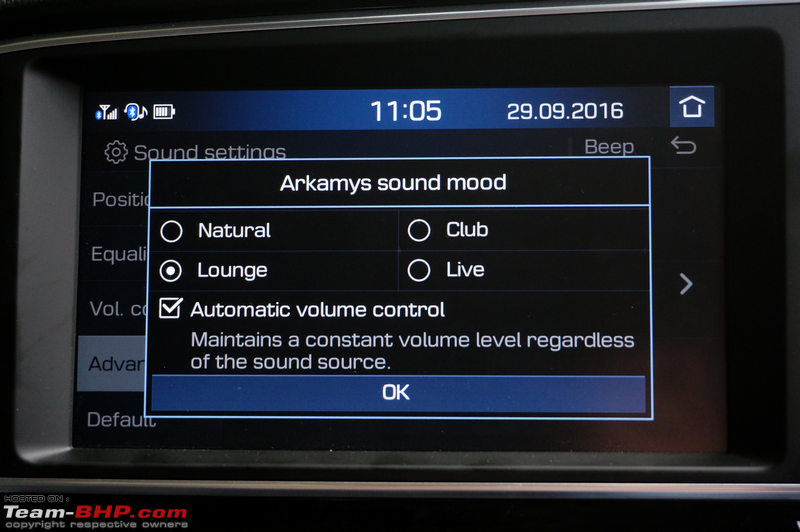 Illumination preferences with individual day / night settings:  Smartphone pairing via Bluetooth is very easy. But remember, it cannot be done when the car is on the move. You need to put the car in neutral and engage the handbrake ("P" in case of the automatic) to pair your phone:  For Android Auto or Apple CarPlay, the phone has to be connected via a USB cable. I think this sort of OS integration is a big deal and makes things so much easier:   You can even pick a QWERTY keyboard...  …and screensaver:  Phone clarity is fantastic and transferring the call from the system to the phone (for privacy) is carried out instantly:  Navigation can be switched to full screen mode as well. Voice has an Indian accent, making it easy to understand: 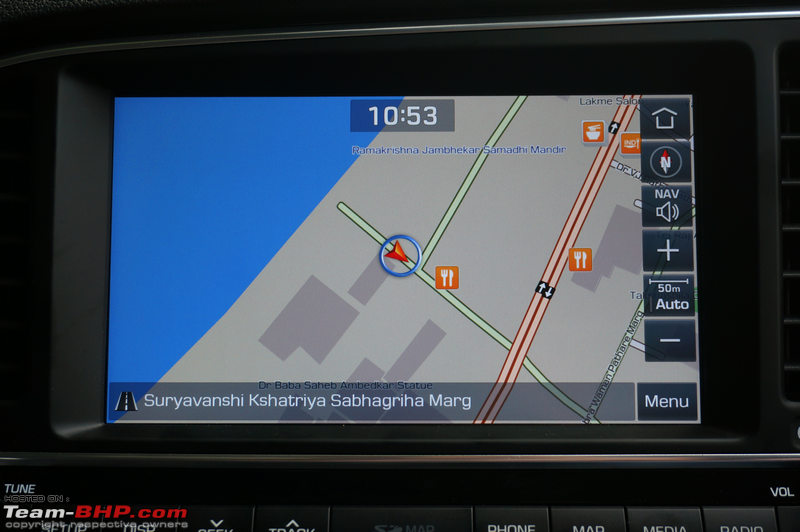 SD Card slot is only for maps (provided by MapMyIndia). They are extremely accurate; worked well even when the car was taken to some rural areas:  View of the map in night mode:  Screen resolution is topnotch, as is the clarity:  Various functions of the navigation system:  Like most GPS systems, a list of POIs is available:  You can store a long list of addresses:  Hyundai dealerships too! Attention to detail is appreciated:  Your coordinates are shown in Degrees / Minutes / Seconds and… 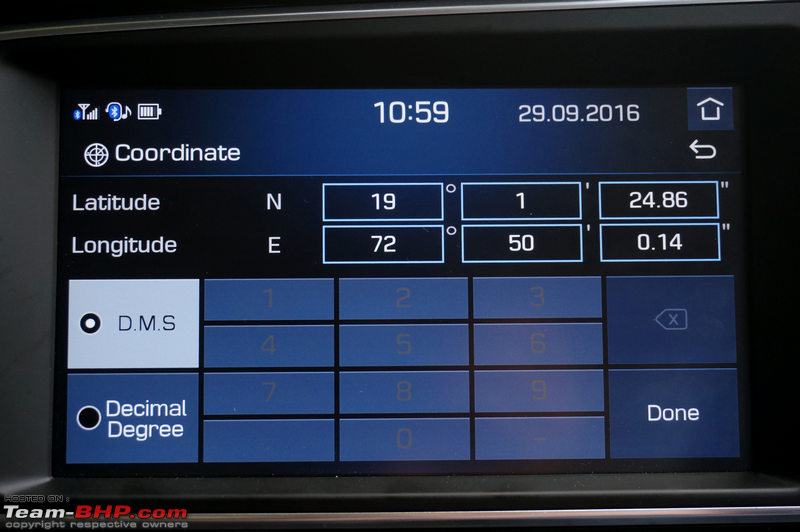 …Decimal Degrees:  Some of the settings that can be changed include the map colour:  And a trace!  Driver is even warned about upcoming curves. This feature is good if you are in unknown territory. On your regular route, it gets irritating and you might want to turn it off (the 'curve ahead' prompt comes up even if you aren't using the navigation):  You can add apps in your preferred sequence to the menu, or remove them via drag-and-drop:  Touchscreen doubles up as a display for the rear view camera, and features adaptive guidelines which indicate the path that the car is going to take. As we have seen earlier, there are 4 rear parking sensors provided as well. When an object is between 24 - 47 inches from the rear bumper, there are intermittent beeps heard while reversing. Between 12 - 24 inches, the beeps are more frequent. If an object is less than 12 inches away, there is a continuous beep:  Pin hole for resetting the system is located next to the tuner knob:  Last edited by Aditya : 28th October 2016 at 10:06. |
| |  (10)
Thanks (10)
Thanks
 |
| The following 10 BHPians Thank Aditya for this useful post: | Crazy_cars_guy, GTO, iliketurtles, Karthik Chandra, Manan_02, MSAneesh, phoenixash, RavenAvi, RSR, Vid6639 |
| | #7 |
| Team-BHP Support  | Driving the 2.0L Petrol MT  Hyundai has used a relatively big 2.0L 'Nu' petrol engine to power the new Elantra. It uses an aluminium block and develops power & torque figures of 150 BHP (@ 6,200 rpm) and 192 Nm (@ 4,000 rpm) respectively. This means that the Elantra has the largest naturally-aspirated petrol engine in its class. It is also the most powerful n/a petrol here, beaten only by the 1.8L 178 BHP Octavia turbo-petrol. When it comes to torque, the Elantra is placed third in the segment, behind the 1.8L and 1.4L (250 Nm) Octavias and the 1.4L (200 Nm) Jetta. The Hyundai comes with a 6-speed MT or AT. The SX(O) and SX(O)AT variants are equipped with keyless entry & go. To start the car, press the clutch and hit the start button. The engine fires up with very little noise and without transmitting any vibrations to the cabin. At idle, it is so silent that you can barely tell if it is running! There are no vibrations felt on the steering or pedals. It's damn refined. Standing still, the 2.0L can revv to 5,000 rpm. Press the clutch and you'll find that it has a long travel range. It is not the lightest clutch I have used, but it's not heavy by any means. No one is likely to complain about it. The gear shifter is light & it's overall nice to use; however, the gear gates aren't well defined and a little effort is required to slot the lever into place. Release the clutch and you'll notice an initial play in it. The car moves forward without any throttle input. You can even pull away from a standstill in 2nd, albeit with a slight input of the throttle. Pulling away from a standstill is no problem for the car. Low speed driveability is satisfactory and the car even feels comfortable doing 50 km/h in sixth gear with the engine spinning at 1,250 rpm. As they say, there's no replacement for displacement! A big engine always comes with its set of advantages. On the open road, the Elantra is what we'd call quick (not f-a-s-t). Performance is more than adequate; however, the Hyundai won't fly off the line like an Octavia 1.8. The Elantra is at its best in the hands of a driver who builds speed in a gradual manner. When pushed, the engine will revv to 6,900 rpm and you'll cross 100 km/h in 2nd itself. The mid-range is where all the action lies. This 2.0L feels most comfortable between 2,000 and 4,000 rpm. That said, the engine doesn't enjoy being thrashed. Over 4,000 rpm, it gets noisy and doesn't pull strongly. It's best to drive with a lighter right foot and cruise on the highway. At 100 km/h, the engine spins over at 2,500 rpm in 6th gear, making the car a relaxed tourer. The Elantra comes with features such as cruise control (can be used above 30 km/h), traction control, electronic stability control and hill-start assist (holds the car for 2 seconds on an incline). Coming to NVH levels, the engine is overall very refined. Under regular driving conditions, the engine can barely be heard inside the cabin. It is only at high rpms that the motor gets very boomy. Road noise creeps in above 100 km/h and a little wind noise could be heard past 120 km/h. Neither of these is disturbing though. In summary, the 2.0L engine will keep most owners happy. However, enthusiasts looking at explosive performance should get the Octavia 1.8T instead. 2.0L naturally-aspirated engine makes 150 horses & 192 Nm torque:  16-valve, VTVT motor has an aluminium block:  ECU is located behind the battery:  Suspension struts are neatly concealed under plastic. Looks so much nicer:  Full cladding on the firewall, but… 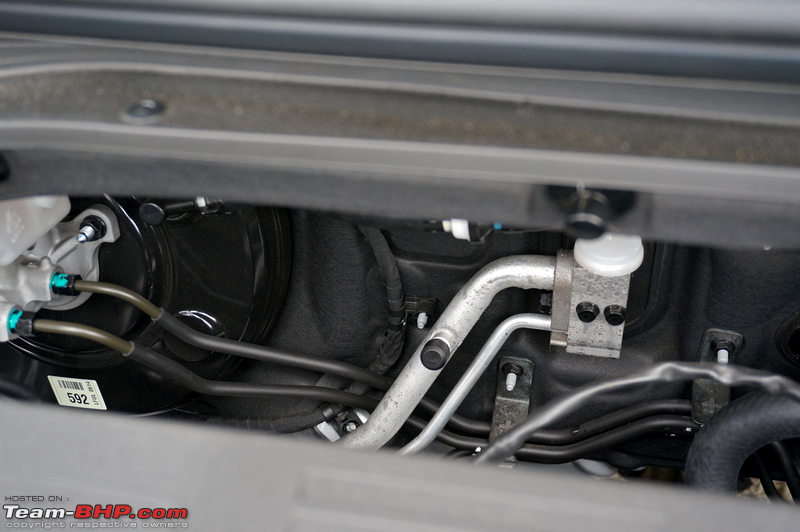 …absolutely no cladding under the bonnet:  No indication of what fuel to feed her. You better give clear instructions to the pump attendant:  6-speed MT. Leather-wrapped gear knob with silver insert looks classy. Reverse is located up, to the extreme left:  Gear lever has a leather boot:  Driving the 2.0L Petrol AT Hyundai offers this 6-speed AT as an option on the Elantra. Considering most premium segment customers prefer slushboxes, it will be a popular one. This is a simple old-school torque converter unit which, along with the 2.0L engine, makes the Elantra a very easy car to drive. Of course, as we have seen with other Hyundai ATs, it's not a fast shifting transmission. The AT goes about its business in a relaxed manner and does a competent job of getting the car from point A to point B. The car gets 3 driving modes - Eco, Sport & Normal. A driver can switch between these modes by using a button placed on the gear console, to the right of the shifter. These modes alter the engine and transmission logic to suit the driver's preferences. Normal mode is the default one which the car runs in. As you would've guessed, this mode provides a balance between economy & power. Eco mode sacrifices power for economy. Driving in this mode, you can immediately feel a difference in throttle response and power delivery. Both are noticeably duller. The air-conditioner's performance is also slightly restricted. Sport mode is the exact opposite of Eco mode. In Sport, the throttle response is sharper and the revvs are held for a longer time. Besides, the steering gets noticeably heavier. If the car is in normal or Eco modes when it is switched off, it will continue in the same mode after restarting. However, if it is in Sport mode when switched off, it will reset itself to normal mode. Like the manual, the start-up is a silent affair. The car moves off the line very smoothly upon releasing the brake (crawl is at ~7 km/h). When the car is driven in a sedate manner, the gearshifts are extremely smooth and one cannot feel any jerk while the shifts are being executed. Together with the light steering, the automatic is a breeze to drive in the city. Owners will enjoy its smooth, refined nature. Press the accelerator hard however, and the transmission appears rattled. The revvs rise and then there is a delay of almost a second before a downshift is executed. The Elantra also tends to shift gears excessively with a heavy foot. It's best to drive it with light to medium-level throttle inputs. Like normal mode, Eco is very useable in the city. As the driving speeds are low, the duller performance isn't a handicap and the car can easily take care of commuting duties. In the city, you won't use Sport mode though as it tends to make the gearshifts jerky. The steering also becomes heavier, which makes it more cumbersome to drive. On the open road, the Elantra is a great cruiser. The engine revvs freely and power delivery is linear. The car can cruise at 100 km/h with the engine revving at 2,100 rpm - 400 rpm lower than the manual. When pushed, it holds on till 6,250 rpm. But again, keeping the relaxed nature of this transmission in mind, it's best to avoid an aggressive driving style. On the highway, Eco mode can be used if you intend to comfortably cruise. But the duller throttle response and lesser performance mean that overtaking quickly is an issue. Here, Sport mode comes in very handy. It makes the engine hold onto revvs a little longer before shifting up. The throttle and engine responses are sharper in Sport and at higher speeds, you will much prefer the heavier steering. For quick overtaking, this is definitely the mode I would recommend. You can use the manual shifting arrangement by pulling the gear lever to the right and pushing the lever to the front to upshift and back to downshift. Honestly though, you should just let the electronics do the shifting. If you're in the mood for speed, engage Sport mode (in D). Of course, manual mode can come in handy when you need engine braking (e.g. going downhill) or when you want to bring the engine into its powerband before an overtaking move. A look at the automatic gear lever. To engage manual mode, move the lever to D and then to the right. Push the lever forward to upshift and pull backward to downshift. Nope, the Elantra doesn't get paddle shifters:  The unlock button:  Blue light indicates which gear has been engaged. Reverse gear gets a red indicator:  Button on the gear console enables the driver to shift between the different driving modes. Press it to cycle between normal -> eco -> sport modes (in this order):  Green indicator for ECO, and…  ...orange for Sport:  Last edited by Aditya : 23rd November 2016 at 14:55. |
| |  (14)
Thanks (14)
Thanks
 |
| The following 14 BHPians Thank Aditya for this useful post: | chinmaypillay, Crazy_cars_guy, GTO, Karthik Chandra, Mindgrinder, MSAneesh, noopster, phoenixash, RavenAvi, RSR, Simhi, StepUP!, Vid6639, VTec_KickedInYo |
| | #8 |
| Team-BHP Support  | Driving the 1.6L Diesel MT  The Elantra comes with the familiar 1.6L CRDi U2 diesel that is found in its predecessor, as well as the Verna and Creta. The engine uses a variable geometry turbo (VGT) and produces an identical 126 BHP (@ 4,000 rpm) and 260 Nm (@ 1,900-2,750 rpm) to the old Elantra. Like the earlier car, it also comes with a 6-speed AT or MT. In terms of capacity and power, this engine is placed behind the Chevrolet Cruze, Skoda Octavia and Volkswagen Jetta (all 2.0s). The only competitor it beats is the 1.4L Corolla Altis. That pretty much sums up its outright performance. One has to press the clutch and hit the start button to fire up the engine. Like the petrol, the diesel's clutch has a long travel range, but it's light enough. The diesel quickly settles down to a quiet idle. Vibrations are also kept in check. In fact, it is very difficult to tell that there is a diesel under the hood...such is the refinement. Things are so smooth on the move that you could confuse it with a petrol. The 1.6L diesel has a practical state of tune. Start off is easy and the diesel has sufficient torque on tap for city driveability. This engine uses a variable-geometry turbocharger that helps keep lag under control. Some amount of lag still exists, yet there is decent torque available at low revvs. It's nowhere as bad as the Corolla Altis 1.4L. The Elantra is at home in the city and doesn't require excessive gearshifts. 2nd gear over a speed breaker? No problem, it'll drive away without any need to downshift to 1st. From a city driving perspective, the ratios are closely spaced and this helps in pulling the Elantra in any gear. You can shift up as early as ~1,500 rpm without lugging the engine. At commuting rpms, the engine is also very silent. On the open road, the Elantra is not a scorcher by any means. It lacks the acceleration of the Cruze, Jetta & Octavia. Still, neither is the Elantra slow. Just that you expect something special when spending 20 big ones. Power delivery is linear and it will suit the sedate driver. The mid-range has reasonable punch and you can make your way through highway traffic. And yes, the throttle does feel sharp. Pushing it will see the diesel revv to 5,100 rpm without feeling too strained. But again, the Elantra isn't about explosive performance - it's quick enough, but not f-a-s-t. What the Elantra does well is cruise. It can munch miles at 100 km/h @ ~1,900 rpm and 120 km/h @ 2,250 rpm (in 6th gear). Further, the diesel is very refined when cruising like this. The ARAI-certified fuel economy of the Elantra diesel is 22.54 km/l, which makes it the best in its class. Owners of the previous-gen Elantra were satisfied with its fuel economy and the 2016 model will be no different. Driving the 1.6L Diesel AT This combination will be a popular choice, perhaps more so than the petrol too, as diesels can provide good fuel economy even with an AT (unlike petrols). Being a torque converter gearbox, that initial turbo-lag is well masked. Light accelerator input is all you'll need to commute in the city. The gearbox moves up early, while shift quality is very smooth. For bumper to bumper traffic conditions, there is a fair amount of 'crawl' available. Just lift your foot off the brake pedal in 'D' and the Elantra will crawl forward at ~7 kph (without any throttle input), allowing you to drive in severe traffic with only one foot. This gearbox is flawless in urban conditions. Just like the petrol, the diesel AT comes with three driving modes – Normal, Eco and Sport. Driven in Normal or Eco modes, the gearbox appears eager to shift up & maximise fuel efficiency. These modes are very useable in an urban environment and one should not have any trouble with them. The only time you'll complain about Eco mode is when you want instant acceleration, floor the pedal and encounter a delay in the downshift. On the highway, the Elantra diesel cruises effortlessly. At 100 km/h, the engine is revving at a leisurely 1,900 rpm, while at 120 km/h, it is turning over at 2,250 rpm. The Elantra AT can be a calm & comfortable long distance cruiser. Eco mode can be used for cruising on the highway. However, when it comes to frequent overtaking conditions (e.g. on a narrow highway), it's best to switch to normal or Sport mode. In Sport mode, the revvs are held longer, which helps when driving fast. Outright performance is adequate, but not 'impressive' like the VW & Skoda competitors. When you want to overtake, the kickdown response time is around half a second before the gearbox downshifts. Par for the course, we'd say. However, if there is a fast vehicle ahead and your overtaking window is narrow, you'll have to carefully plan the move (or use 'manual mode'). While the gearbox takes half a second to react in most conditions, there are some where it'll take a full second. It's conditions like these where the Jetta / Octavia diesel have an advantage due to their more powerful engine & quicker gearbox. Like its engine, the Elantra's gearbox is suited to calm driving, maybe even a little bit of pushing, but not an aggressive driver. Push hard with constantly changing throttle inputs and the AT can end up confused...not shifting when you want it to and vice versa. Manual mode is useful when you want to prepare the car for overtaking a fast vehicle on a 2-lane highway, or when you desire engine braking. The response time to your commands is reasonable. What is bothersome is that it's tuned too conservatively (you can forget about aggressive downshifts). CRDi badge on the front right fender is the only indication of the oil-burner under the hood:  Unlike the petrol, the diesel’s fuel flap and cap feature clear markings about its diet:  Elantra diesel gets an insulation sheet under the bonnet:  Tried and tested 1,582 cc diesel engine develops 126 BHP & 260 Nm of torque:  Fair amount of underbody protection:  Turbocharger is placed behind the engine:  Gear lever and console are shared with the petrol. If you switch the car off in D / R / N, it won't turn off entirely. Instead, the car will engage accessory mode, with an orange light on the start stop button. Additionally, a bong will keep sounding off until you put the car in P. Without doing so, you won't be able to lock the car either...the horn will start blowing!  Last edited by Aditya : 28th October 2016 at 10:09. |
| |  (13)
Thanks (13)
Thanks
 |
| The following 13 BHPians Thank Aditya for this useful post: | chinmaypillay, Crazy_cars_guy, GTO, iliketurtles, Karthik Chandra, MSAneesh, phoenixash, RavenAvi, RSR, Simhi, StepUP!, Vid6639, VijayAnand1 |
| | #9 |
| Team-BHP Support  | Ride & Handling The Elantra uses a McPherson strut suspension setup at the front and a coupled torsion beam axle at the rear. Cars like the Jetta & Octavia (some variants) offer a superior multi-link rear suspension. The Hyundai absorbs bumps well at low speed. It is also a quiet performer as long as the road is smooth. However, the setup is a little firmer than what we have seen on most Hyundai cars. Sharp bumps are felt and bassy thuds are heard in the cabin. At higher speeds, the ride is a lot better controlled than before. The vertical movement (from the rear) experienced in many other Hyundais, isn't as pronounced. Overall, it's a step forward and owners will be satisfied with the comfort levels offered by this suspension. The steering is one finger-light at parking speeds and feels quite direct. It turns 2¾ times from lock to lock. Additionally, the turning circle is tight for a car of its size. This makes the Elantra easy to punt around in the city. The steering weighs up adequately at higher speeds. And don't forget, in variants equipped with different driving modes, you can choose between normal (lighter steering) & sport (stiffer steering) modes at any speed. The EPS still lacks feel though. The high speed poise of the car is satisfactory. The 205/60 section Hankook tyres provide good grip around corners; what's more, you have electronics (ESP) covering your back in emergency conditions. The body roll is within acceptable limits & most drivers will find the handling to be neutral. Enthusiasts however will find that the car loses its composure if pushed very hard through corners. It can also get unsettled on mid-corner bumps. The experience is definitely not in the same league as a Jetta in terms of dynamics. That said, it is still one of the best handling Hyundai cars I've driven. The Elantra has a ground clearance rating of 165 mm. That's lesser than the Corolla Altis, but higher than the Jetta & Octavia. We'll leave comments on how it handles big bumps with a full load of passengers to our ownership reports. As is the standard in this segment, the Elantra comes equipped with disc brakes on all 4 wheels. ABS with EBD is standard as well. The brakes do a fair job of stopping the car. The Elantra stops in a straight line and the ABS isn't too intrusive, kicking in only under very hard braking. However, the brake pedal travels a good inch and a half before the brakes begin to bite. The pedal has a spongy feel too. Last edited by Aditya : 28th October 2016 at 10:11. |
| |  (19)
Thanks (19)
Thanks
 |
| The following 19 BHPians Thank Aditya for this useful post: | Crazy_cars_guy, GTO, iliketurtles, Karthik Chandra, mh09ad5578, MSAneesh, phoenixash, PrasunBannerjee, Rajeevraj, RavenAvi, RSR, Simhi, sourabhzen, StepUP!, sups, The Rationalist, Vid6639, VijayAnand1, VTec_KickedInYo |
| | #10 |
| Team-BHP Support  | Other Points • It's depressing that the manual transmission SX(O) doesn't get all the kit of the automatic SX(O). Manual lovers will miss out on stuff like 6 airbags, ventilated seats, selectable driving modes & the sunroof. Just like we saw with the Creta, Hyundai has a knack of messing the variants up. • Here's the point of view of an Octavia owner! Thanks to Adi_petrolhead for sharing - link. • Developed at Hyundai’s Namyang R&D center in Korea. • Assembled at Chennai from Korea-sourced CKD kits. • Hyundai is targeting sales of approximately 350 units per month - Source. • The company claims to have received over 1,100 bookings within 6 weeks of launch. • Standard warranty of 3 years / 1,00,000 km. 4th year extension available for Rs. 20,000. Hyundai's existing customers (those who currently own a Hyundai car) are given the 4th year extended warranty free. • Fuel tank capacity = 50 liters. • 2.0L petrol engine has an ARAI rating of 14.59 km/l for the MT and 14.62 km/l for the AT. 1.6L diesel has an ARAI rating of 22.54 km/l for the MT and 18.23 km/l for the AT. • First service at 1,500 km / 2 months, second at 10,000 km / 12 months. Subsequent services after every 10,000 km / 12 months. • Strangely, the petrol AT is available in the SX trim level, but not the diesel AT which only comes in the SX(O). • Available in 5 colours - Marina Blue, Polar White, Sleek Silver, Phantom Black and Red Passion. • Drag co-efficient of 0.29. • Shockingly, only the SX(O) AT variant gets auto-locking doors. • Impact sensing door locks are standard on all variants. • Worldwide, Hyundai has sold over 11.5 million copies of the Elantra since it was first introduced in 1990. • Disclaimer : Hyundai invited Team-BHP for the Elantra test-drive. They covered all the travel expenses for this driving event. Last edited by Aditya : 28th October 2016 at 10:13. |
| |  (18)
Thanks (18)
Thanks
 |
| The following 18 BHPians Thank Aditya for this useful post: | adi_petrolhead, chinmaypillay, Crazy_cars_guy, GTO, iliketurtles, Karthik Chandra, mh09ad5578, MSAneesh, noopster, phoenixash, Rajeevraj, RavenAvi, RSR, Simhi, sourabhzen, StepUP!, sumeethaldankar, Vid6639 |
| | #11 |
| Team-BHP Support  | The Smaller yet Significant Things Apart from the silver colour of our test car, the Elantra is available in 4 other shades. Here, it is seen in Phantom black…  …Marina Blue…  …and Red Passion. The fifth colour is Polar White:  Fit and finish are very impressive. Even the shut lines around the bonnet aren't wide:  Full cladding in the front wheel well…  …and the rear:  A look at the tidy underbody & 50L fuel tank:  Whether the car is loaded or not, it's 33 PSI all round:  All the buttons on the dashboard are lit up in cool blue (when the pilot lights are switched on). The climate control displays the temperature in Centigrade or Fahrenheit, depending upon the MID settings:  Seatbelt buckles have a soft felt-lining that prevents scratches from rubbing against the center console:  The SX(O) variant gets 6 airbags in total. The side airbags are housed in the front seats…  …while the curtain airbags are housed in the B-pillars:  Chocolate brown is such a poor colour choice! Wonder why Hyundai persists with it. Smartkey with chrome inserts is shared with the Elite i20 & Creta:  VIN is engraved on a beam, below the driver's seat:  Two hooks to stop the driver's floor mat from sliding around:  Passenger's footwell gets a hook too:  Last edited by Aditya : 28th October 2016 at 10:14. |
| |  (25)
Thanks (25)
Thanks
 |
| The following 25 BHPians Thank Aditya for this useful post: | Aficionados, bonnyhere, chinmaypillay, Crazy_cars_guy, daverm, dkaile, GTO, iamendangered, iliketurtles, Karthik Chandra, KPS, mallumowgli, motoholic31, MSAneesh, murajith, noopster, phoenixash, Rajeevraj, RavenAvi, RSR, sidzz, sourabhzen, Vid6639, VijayAnand1, VTec_KickedInYo |
| |
| | #12 |
| Team-BHP Support  | Re: Hyundai Elantra : Official Review Thread moved from the Assembly Line to Official Reviews. |
| |  ()
Thanks ()
Thanks
 |
| | #13 |
| BHPian Join Date: Aug 2016 Location: Delhi
Posts: 122
Thanked: 260 Times
| Re: Hyundai Elantra : Official Review This car is going to sell bucket loads for Hyundai (keeping in mind creature comfort and feature hungry Indian market). Though I feel the diesel engine is a tad too underpowered for the segment. Also, as is common for the D1 segment this looks to mostly be a chauffeur driven car. That blue colour looks gorgeous, Hyundai should introduce this in its remaining cars as well |
| |  (5)
Thanks (5)
Thanks
 |
| The following 5 BHPians Thank dhruvwali for this useful post: | Aditya, GTO, motoholic31, RSR, sri_tesla |
| | #14 |
| BHPian Join Date: Dec 2007 Location: Kolkata (WB)
Posts: 505
Thanked: 1,059 Times
| Re: Hyundai Elantra : Official Review 5 - star review as always!  I have been a die-hard Honda & Toyota loyalist till date. The new Elantra has really made me sit up and take notice. Hyundai have really put in a lot of effort and thought into the new car, and it shows! Hyundai has really worked hard and taken their quality to very impressive levels. The overall package offered is also amazing VFM. The new Elantra (waiting to see the Tucson too) could just be my very first Hyundai next year. I would look to go for the Petrol SX(O) AT for all the bells & whistles it offers. I am really impressed by infotainment system's numerous customization options. Only limitations I see are the small boot and slightly difficult ingress-egress for rear seat passengers. Other than that, Hyundai have a winner. As I was reading elsewhere on T-BHP,' Hyundai is the Honda'. Can't agree more. |
| |  (3)
Thanks (3)
Thanks
 |
| The following 3 BHPians Thank fordfreak for this useful post: | Aditya, GTO, RSR |
| | #15 |
| Senior - BHPian | Re: Hyundai Elantra : Official Review I read through the entire review, and barring a slightly underpowered diesel engine plus a slightly restrictive variant choice, failed to notice any cons ! Hyundai have a winner in their hands for sure - they just have to advertise these features correctly at the mentioned pricepoint. Also - some of these features, alongwith the design philosophy, should make their way to the new Verna - Hyundai has got to a weak position in that segment and needs a shot in the arm. |
| |  (3)
Thanks (3)
Thanks
 |
| The following 3 BHPians Thank blackasta for this useful post: | Aditya, GTO, RSR |
 |


